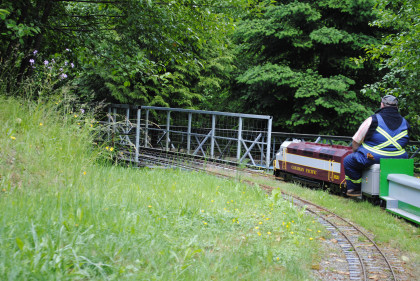
The NRHS convention continued today with seminars but the British Columbia Electric Railway's interurbans in Surrey and Burnaby were the focus and destination for today. Little did I know at that time how involved I was to become with them in the future.
After breakfast, myself, Bob and Chris drove the one hundred miles from Lynnwood to the Surrey suburb of Sullivan and met John Sprung, chairman of the Fraser Valley Heritage Railway Society and the secretary, Allen Aubert.
British Columbia Electric RailwayThe BCER was an interurban electric railway formed in 1897. The railway's origins lay in the Vancouver Railway and Lighting Company, a street railway, started around 1890. Financed largely with British capital, the company was formed by Francis Barnard and Robert Horne-Payne, a British financier. The company was reorganized a number of times under several different names before settling on BCER in 1897. Within a couple of weeks, they had taken control of the electric rail systems in New Westminster, Vancouver and Victoria. The company's major goal was to run the entire railway using electricity, rather than steam. To accomplish this, they needed to produce their own source of electrical power. This led to the development of an electric plant at Buntzen Lake in 1903, followed by a second plant at Stave Falls. The main purpose of these plants was to provide electricity to power the railway. At its height, BCER provided interurban service on three lines covering a large portion of southern BC. The company also provided municipal transit service in Greater Vancouver and Victoria. BCER grew to become one of the most extensive electric railways in the world. In 1961, the BC Electric Railway was taken over by the newly-formed BC Hydro, a publicly owned utility. The line was fully dieselized by 1970. BC Hydro continued operating the railway until 1988, when it was sold to the US-based Itel Rail Group. Shortly after that, it was renamed the Southern Railway of British Columbia (SRY). As part of the deal, both the province and BC Hydro retained the rights to reintroduce passenger service.
The Fraser Valley Line was completed in 1910 and that passenger service was inaugurated on October 3rd, 1910. When completed, the BCER ran from downtown Vancouver out to Chilliwack. There were up to four complete round-trip runs each day. Carrying not only passengers, it also provided a fast method for moving freight, the mail and gossip. Another goal of completing the rail line was to electrify the valley. Modern conveniences, such as electric light and telephones, came to the valley as the rail line spread up from the Fraser river and through settlements. Over time these settlements grew into the town centers and cities we find today: Whalley (Surrey City Center), Newton, Sullivan, Cloverdale, Langley, Abbotsford and Sumas.

BCER interurban car 1225, built in 1912 and worked in Vancouver, Steveston and Burnaby from 1913 until February 28th, 1958. In the early 1950's, as the BCER was being wound down, many of the cars were decommissioned. Most ended up being burnt at the rail yard under the Burrard Street bridge. Some were purchased and moved to museums south of the border. BCER 1225 found its way to the Orange Empire Railway Museum (OERM) in Perris, California. In August 2005, BCER 1225 returned home to Canada after a fifty-year absence on two flat cars. Hundreds of volunteer hours had gone into the restoration.
Looking up at the interurban which was raised so the trucks and undercarriage could be worked on.
The ceiling and racks of the restored 1225.
Allen Aubert sitting in the competely restored interior. To say it looked extremely impressive is an understatement. While the materials were bought or donated by local businesses, the work was done by the skilled and able volunteers.
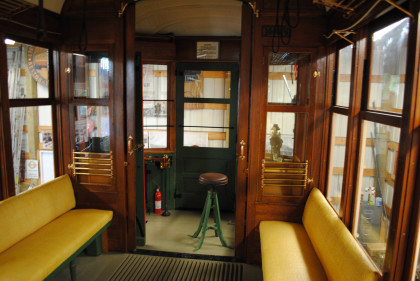
Looking toward the motorman's area.
Map of the B.C. Electric Railway lines in Greater Vancouver and the Fraser Valley.
The emblem of the Steveston Interurban Restoration Society, which at that time, owned BCER 1304.
BCER interurban 1304 "Connaught", also undergoing restoration. Built in 1911, this car was on the 1912 Royal Tour of Canada and was named for the Governor- General of Canada, the Duke of Connaught. After that the car ran on the Chillwack Line then in 1945, it caught fire and burned to its steel frame. It was then rebuilt and returned to service running until October 1950. 1304 had not been out on the Chilliwack line for almost five years, but when Yarrow teacher Miss J.E. Fowlie wondered in a letter to President Grauer if her Grade Three students might not have a train ride to round off a study unit on transportation, it was as good as done. One of the diesels hauling a freight train brought 1304 to Chilliwack, where the thirty-eight students, with their teacher, boarded it for a forty-five minute ride to Yarrow. After the students had inspected the train's caboose, the freight train continued on its way to New Westminster, leaving behind a class of bubbly, still wide- eyed children." Car 1304 left Canada in 1955 and moved to Glenwood, Oregon to reside at the "Trolley Park" of the Oregon Electric Railway Historical Society. After fifty years, it returned to British Columbia in April 2009.
Interior of 1304. A speeder ride was then offered to us.
The Fraser Valley Heritage Railway's original speeder.
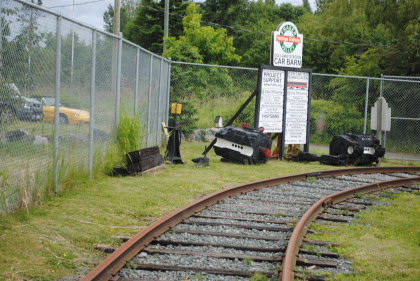
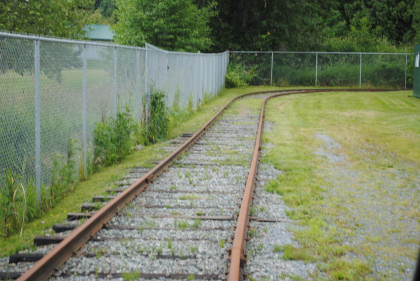
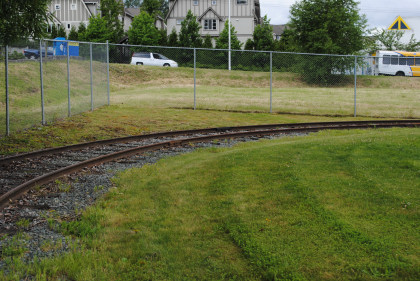

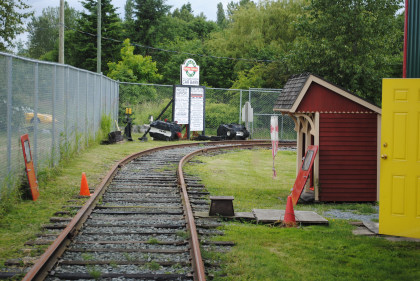
Views from the trip around the property.
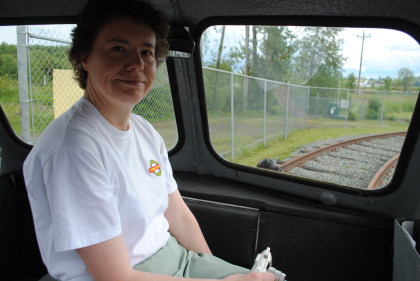
Myself enjoying the second speeder ride of my life. John and Allen then invited us to join them for lunch at the Java Hut, which we took them up on. After a very enjoyable conversation and lunch, the three of us drove to Burnaby Village Museum in search of another BCER interurban.
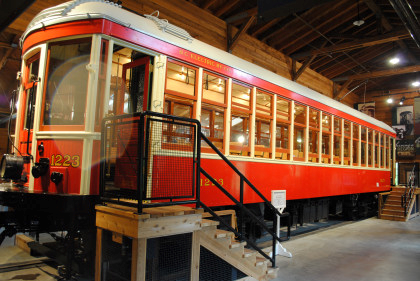
British Columbia Electric Railway interurban 1223 built in 1912. It entered service in 1913 and was retired in 1958. It was one of only seven B.C. Electric Railway cars saved from destruction. It was displayed outside in Burnaby but was vandalized and deteriorated in the elements to the point that it need to be restored and placed inside which happened after it arrived at the Burnaby Museum and Heritage Village.
End view of the interurban car.
History and information about BCER 1223.
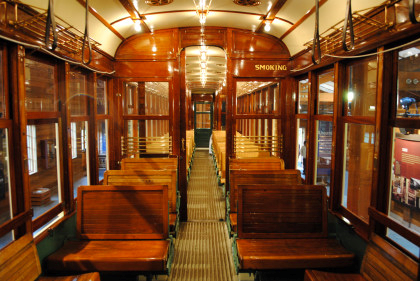
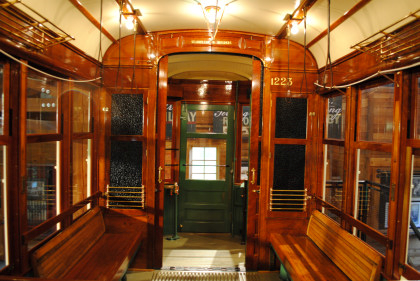
Interior views of 1223.
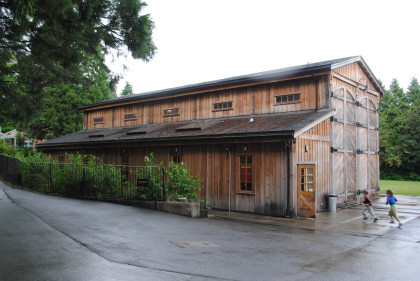
The building in which BCER 1223 is housed.
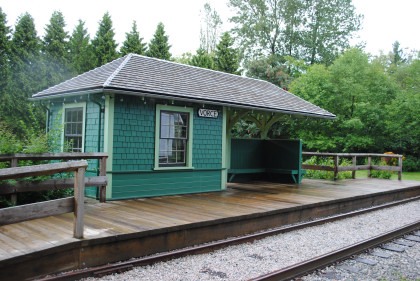
The British Columbia Electric Railway Vorce station, the last remaining interurban station in Burnaby and one of the few extant structures left in the Greater Vancouver region that were once part of the extensive BCER system. It was designed and built by the BCER at the foot of Nursery Street on the Burnaby Lake line and is typical of the small local passenger stations on the Burnaby Lake and Chilliwack interurban lines. The wood frame structure has a rectangular plan and hipped roof. It is enclosed on three sides, with an open side for access to the train platform and a single long built in bench across the back of the station. It was named after C. B. Vorce, the Chief Engineer for the company. In 1953, it was moved to a local farm by the Lubbock family and in 1977, was relocated to the grounds of the Burnaby Village Museum.
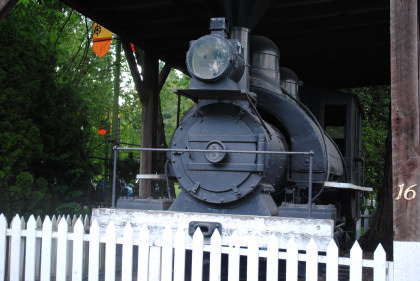
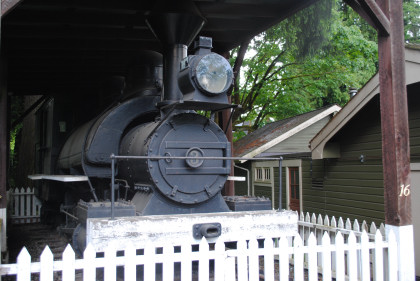
An unexpected find was Canadian Pacific 0-4-4T 3 "Curly" built 1879 for use in the construction of the San Francisco Sea Wall, then sold to the Canadian Pacific Railway before going to D.O. Mills and Company, then B.C. Mills Timber and Trading in 1888. After that it became Hastings Saw Mill Company 3 in 1926. In 1973 the engine was displayed at the Pacific National Exhibition. Years later it became a part of the Burnaby Museum; thus this is the oldest existing Canadian Pacific steam engine in the country.
There was one other place to visit while in the Greater Vancouver Regional District, also in Burnaby.
Burnaby Central Railway
Operated by the British Columbia Society of Model Engineers, the group's history goes back to 1929 when several miniature railway enthusiasts came together to form a model engineering club. Many of them had home workshops, and in their spare time lovingly created miniature locomotives. At that time the club did not have a track of its own and members met from time-to-time at tracks that existed on someone's private property to run their trains. Naturally, these members wanted to share the fruits of their labours with other enthusiasts and the public, and to re-kindle the memories of that bygone era when most people travelled long distances by train. The search was on for a property of their own, and finally on July 1st, 1975, the club opened its doors to the public at the track which was located at the Burnaby Village Museum. Over time it was found that the site was not large enough to meet their needs and there was no room for expansion. Burnaby Parks assisted in relocating to their present seven-acre site, which had been used as a municipal works yard. In late 1991, the BCSME closed their original track, and after almost two years of back-breaking work, opened at our current location in Confederation Park on Dominion Day 1993. Landscaping of the current site included 8,500 loads of fill from the Cassiar Connector highway project with which four hills were created.
The track layout of Burnaby Central Railway. Joe Holman met us and showed us around the car barn area first.
Rainbow Creek Station, the location of the ticket office and gift shop.
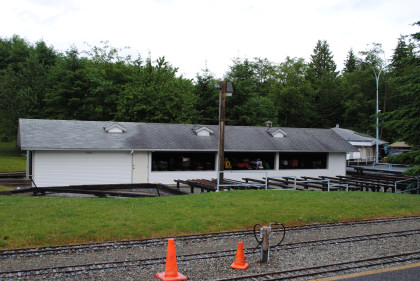
The car barn.
Close-up of the car barn and tracks.
The turntable.
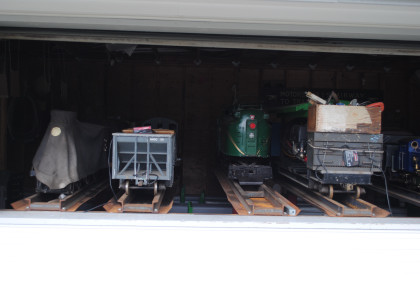
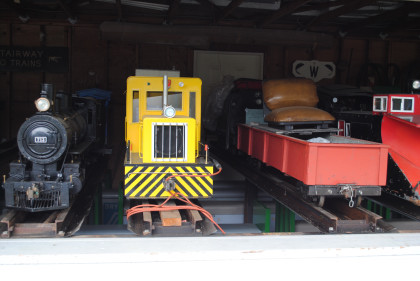
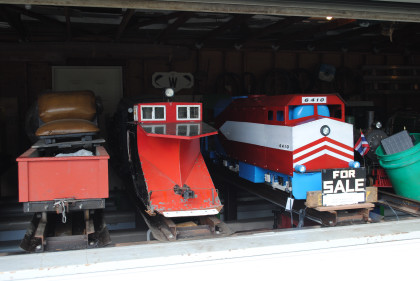
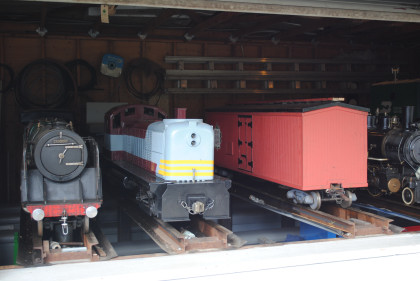
Part of the impressive collection of Burnaby Central's and some privately-owned live steam engines.
The only logging engine of the Burnaby Central is this Climax, owned by one of the volunteers.
Canadian Pacific Railway 4-4-0 374, a one-eighth size model of the first locomotive to arrive on the West Coast in 1886. It is privately owned and was built by one of the Burnaby Central's founders.
Another privately-owned 7 1/2" gauge steam engine.
Joe then brought out Canadian Pacific F40PH 1920 for our ride.
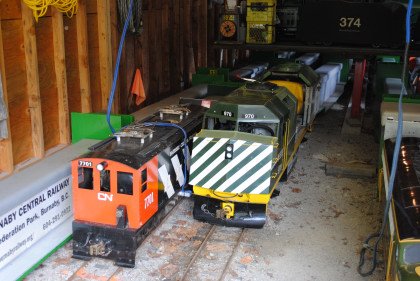
Other locomotives in the car barn.
At the station before we get underway.
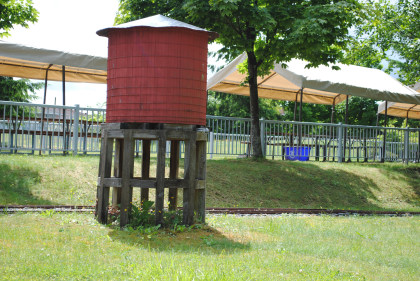
The water tower.
Rounding a curve as we start our ride on every section of trackage.
Passing the miniature station on the grounds.
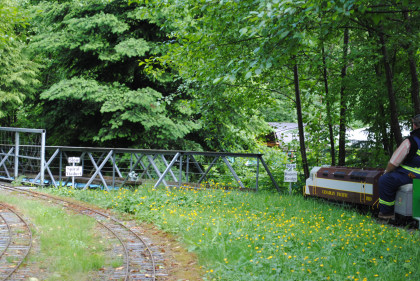
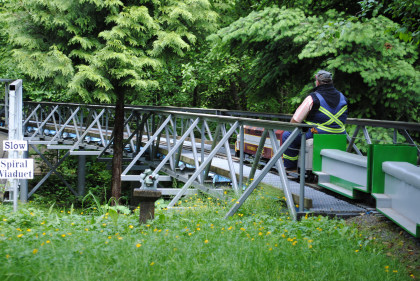
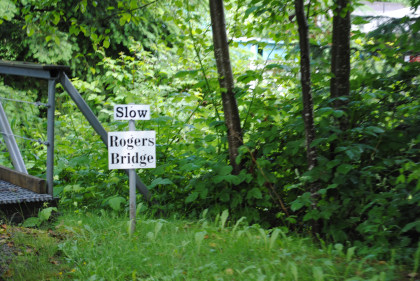
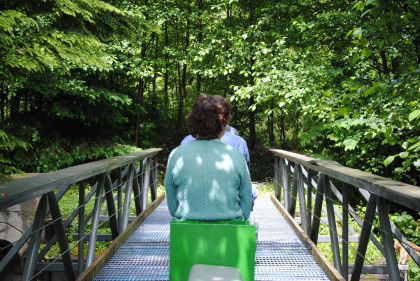
Going over Rogers Bridge; the latter photo by Chris who was sitting in a car behind.
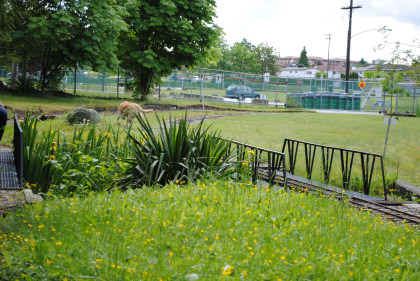
We went past the twin bridges, which we would later go under.
About to enter the Long Tunnel.
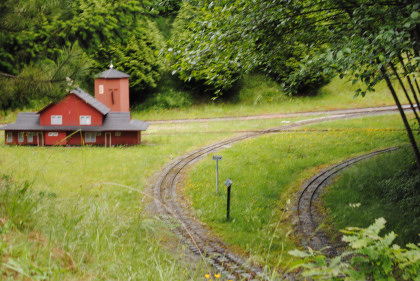
We passed Rainbow station and went behind it, then went on the other set of tracks by the miniature station.

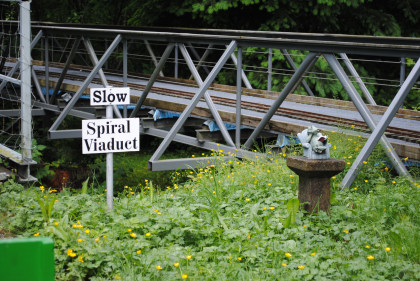
Later we crossed the Spiral Viaduct. Our trip kept on going and we had a fantastic time riding the complete Burnaby Central Railway. Upon our return to the station, Joe gave us a tour of the steam shop.
New York Central steam engine 5279 being brought to life by one of the volunteers.
Tender of New York Central 5279 and caboose.
A Pennsylvania Railroad GG1, which used to be at the Model Railroad Museum on Granville Island.
This steam engine can only operate on the smaller elevated track.
A 2-6-0 in the steam shop.
The second steam engine of the Burnaby Central. Henry Greeley designed this and the BCSME acquired it in the 1970's, rebuilding and modifying it to resemble a Canadian National 4-8-4.
This was actually my second time at Confederation Park. Two months earlier, on Easter Sunday, my mother, Bob and I visited and unbeknownst to any of us until we bought our tickets, I was the 500,000th rider! I received a ticket for twelve free rides (I still have several rides left as of March 2021) and my choice of souvenir which was a T-shirt.
| RETURN TO THE MAIN PAGE |